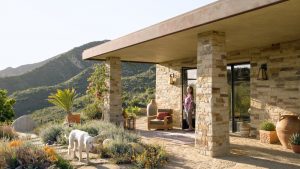Wildfires are changing the California real estate landscape. In late 2017, a single wildfire torched nearly 141,000 acres of land, forcing 212,000 to evacuate a massive section of southern California. More than 86,000 homes in Ventura and Los Angeles counties are at risk of severe damage by wildfire, and future blazes can extend farther north. Every southern California real estate decision should be informed by the potential for wildfire damage. To that end, basic architectural design decisions can greatly improve the chances of your home surviving one of these disasters.
Before we discuss architectural decisions, we should talk about location. The chaparral biome is most susceptible to wildfires; characterized by hot, dry summers and very mild winters, this climate encompasses southern California and northern Mexico, heightening the risk for fires. If you can help it, try your best to avoid this type of climate and ecosystem. Another way to address the risk? Build a sustainable mobile home or invest in a trendy “tiny house.” When the winds pick up, you can bring your house along to safety.
Protecting your home against wildfires starts with understanding the ways in which your home may be at risk. This starts with the exterior. When designing your southern California home, invest in ignition-resistant roofs. Some of the most insidious problems drip down through cracks and openings in the traditional Spanish tile roofs. These materials, with help from the wind, may only seek to exacerbate any wildfire coming in your direction. Builders may offer the option to fire-stop individual tiles in an existing roof, but you should choose tiles made of fire-rated roofing materials, picking a design that interlocks tightly.

Story Kornbluth and her dog Khallie at her home in Santa Barbara, CA.
Window protection is imperative in the southern California heat. The weakest link in defending against fires, you should focus on fire-proofing these features with a roll-down metal fire protector. Easily hidden by drapes and curtains, this is one of the only ways to protect yourself from shattering glass in the case of a wildfire. Moreover, builders should extensively research ember resistant exterior availability. Stucco, fake brick, tile, and concrete block—all climatologically appropriate and widely available—are perfect for resisting wildfire. Be sure to devote attention to the underside of overhangs, as flames may be trapped, resulting in very high temperatures.
Designing a new home (or redesigning your existing home) should be exciting, not scary. In implementing a few of these suggestions, you can increase the likelihood that your home will survive a potential wildfire; the decisions you make during the building process will determine the impact your home makes on the environment.